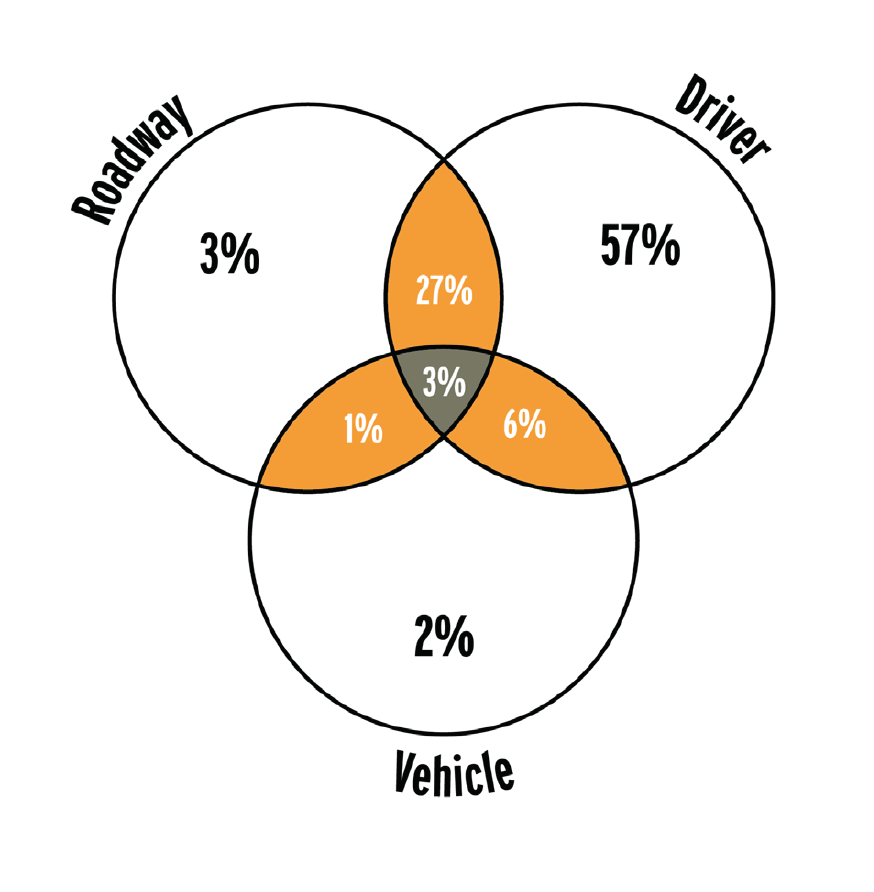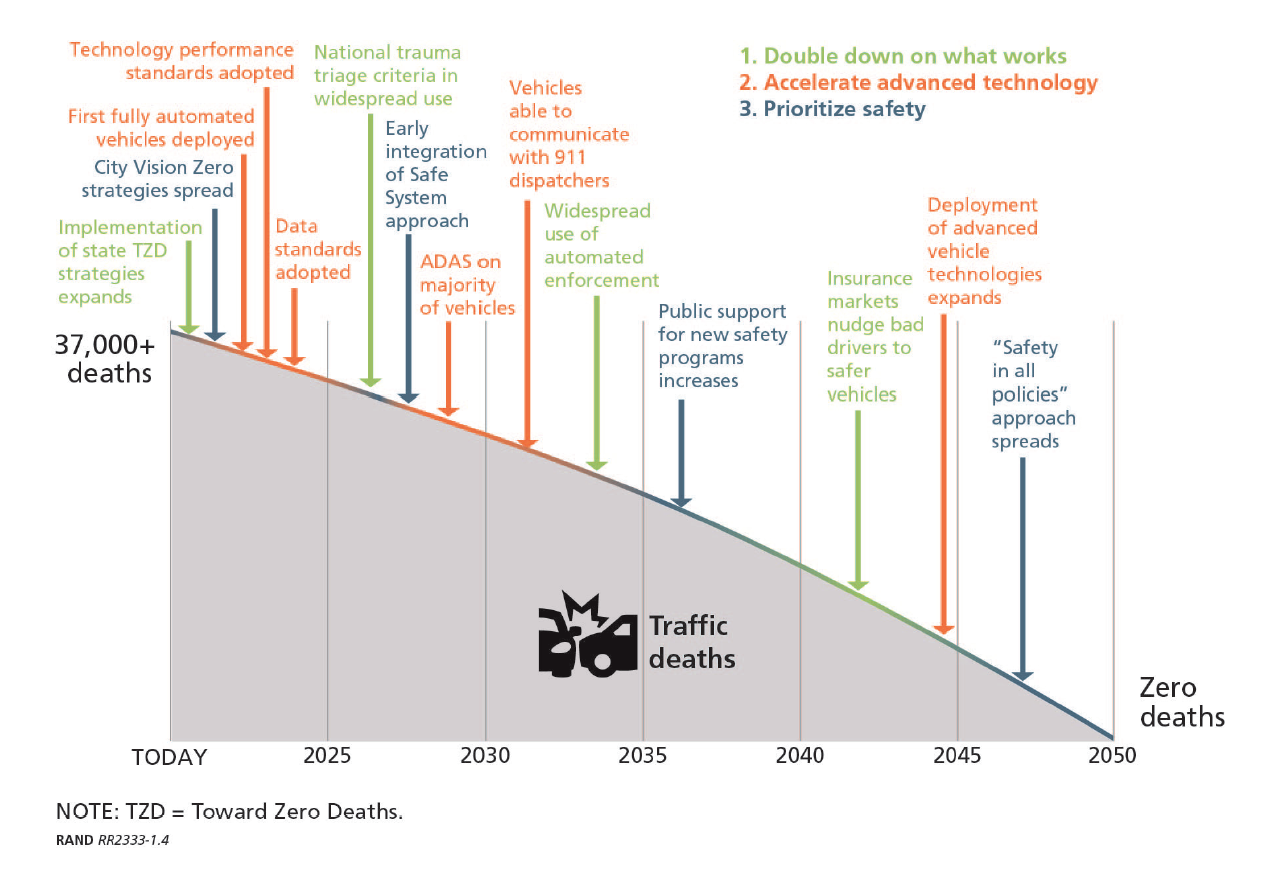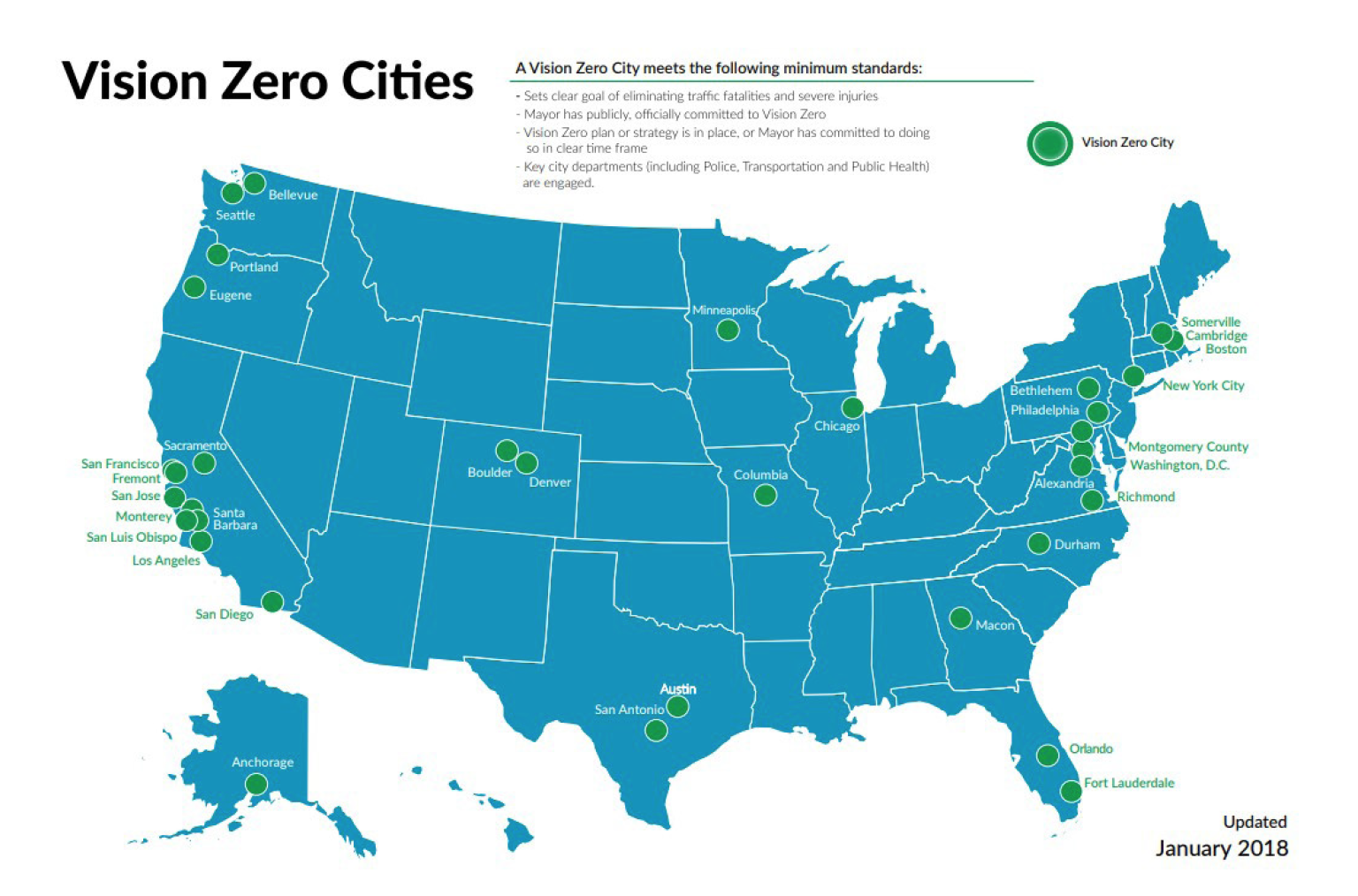The state of road safety in the United States has led to several distinct movements organized around the concept that all traffic deaths are preventable and that the only acceptable number of traffic deaths is zero. The concept of framing traffic safety in this way and pursuing an approach that can achieve the goal of zero traffic fatalities began in 1994 in Sweden and was codified in Swedish law by a 1997 Traffic Safety Bill. 8 Since 1997, Sweden has exported its concept and strategies to more than 60 countries. In 2016, Sweden experienced 270 traffic fatalities, with 27.3 traffic deaths per 1,000,000 inhabitants– about a quarter the per capita traffic fatality rate of the United States. 9 In the United States, three organizations or initiatives incorporate the idea of Vision Zero into their missions. The following summarizes each group and its work to help people interested in how the work of these groups impacts people who bicycle and walk.
Toward Zero Deaths
Started in 2009, 10 the Toward Zero Deaths movement is composed of national traffic safety organizations and state departments of transportation. Of the Vision Zero-related groups, it is the most centered on individual behaviors. Examples of this focus can be found in the assertion that “[t]he element of the transportation system that contributes most frequently to the occurrence of traffic crashes is the driver” 11 and the Venn diagram produced in the Towards Zero Deaths Strategy that identifies how drivers, vehicles, and roadways contribute to traffic deaths.

Footnote 12
When dealing with bicyclists and pedestrians, this group says, “Successfully protecting vulnerable road users relies on a combination of improving infrastructure and planning, enacting, and enforcing legislation, and targeting education programs to specific road user audiences. These initiatives may require that road users behave in a certain way or use protective equipment, which can generate controversies related to personal freedoms, privacy, and the ability to enforce laws.” 13
Interventions proposed by the Toward Zero Deaths movement often focus on individual behavior and stress balancing safety and mobility when creating the built environment. 14 As an example, the Toward Zero Deaths’ National Strategy says, “Elements of the roadway environment, including travel lanes for all motorized vehicles, traffic signs and signals, and bus stops and other transit access points, must be designed to balance the safety and mobility of all travel modes expected to use the roads. This balance is challenging because of the different characteristics and needs of each type of road user. Road designers must evaluate the expected effect of infrastructure treatments on all types of road users—even treatments intended to address the contributing factors for crashes involving vulnerable users—to make the most appropriate decision for individual situations.” While human behavior may be the primary focus of the Toward Zero Deaths movement, there appears to be no discussion of important contexts that impact human behavior such as land use, access to a vehicle, or poverty that may impact the mode choice or behaviors of people in different communities beyond the design of a road in its strategy.
Road to Zero Coalition
Started in 2016, 15 the Road to Zero Coalition includes many of the organizations involved in Toward Zero Deaths but is a notably broader movement led by the National Safety Council and several federal agencies. The Road to Zero Coalition also has a more specific goal: “To eliminate traffic fatalities by 2050.” As of January 2018, the Road to Zero Coalition had 629 members, including 156 advocacy and survivor advocacy groups. In April 2018, the Road to Zero Coalition published its first report, “The Road to Zero: A Vision for Achieving Zero Roadway Deaths by 2050.” 16

Footnote 17
The Road to Zero Coalition outlined three approaches to achieve zero roadway deaths by 2050:
1 » DOUBLE DOWN ON WHAT WORKS
Use the established network of traffic safety experts in the United States while engaging businesses and political leaders to a greater extent to provide new energy to traffic safety efforts.
2 » ACCELERATE ADVANCED TECHNOLOGY
Continue and reinforce deployment of advanced vehicle technologies while creating new partnerships with emergency medical and trauma systems and others in the public sector to increase the speed of new-technology adoption in all aspects of the traffic safety system.
3 » PRIORITIZE SAFETY
Create a safety culture and spread the adoption of the Safe System approach. “Adopting the Safe System approach involves a fundamental shift from the common assumption that crashes generally happen because of people’s behavior.” 18
The Road to Zero Coalition goes on to present three principles of a Safe System approach 19 :
A SAFE SYSTEM ACCOMMODATES HUMAN ERROR
Rather than focusing on stopping all human error, a Safe System approach focuses on accommodating human error, meaning that errors can be made without catastrophic consequences. As an example, [s]lowing traffic on streets where pedestrians and bicyclists are present allows more reaction time and reduces injury levels when inevitable conflicts occur.
SAFE SYSTEMS SHARE RESPONSIBILITY.
A Safe System approach is characterized by shared responsibility, including roadway design and vehicle design, as well as road user behavior.
A SAFE APPROACH IS PROSPECTIVE
Rather than reacting to crash and fatality data, a Safe System approach looks to identify where crashes might occur in the future and considering all ways that crashes can be prevented.
While each of the principles above is important, the most dramatic change of a Safe System approach is the shift of responsibility from the individual user of the roadway to the people who design the transportation system. While the Toward Zero Deaths National Strategy assigns 57% of the responsibility to drivers, the Safe System approach appears to place the majority of responsibility on the “people who design the transportation system— city planners, traffic engineers, and vehicle designers” 20 rather than individuals using the system.

BFA – Bicycle Roundabout, courtesy of UC-Davis
Vision Zero Network
Started in 2014, the Vision Zero Network is committed to helping communities reach their goal of Vision Zero–”eliminating all traffic fatalities and severe injuries while increasing safe, healthy, equitable mobility for all.” 21 The Vision Zero Network articulates its goal and approach as “a significant departure from the status quo” 22 in at least three ways: 1) acknowledging that traffic deaths and severe injuries are preventable, 2) setting a time frame for eliminating these preventable deaths and injuries, and 3) intentionally pursuing a multidisciplinary approach not centered on any one type of intervention.
The focus of the Vision Zero Network is on process rather than outcomes, although it is explicitly organized around one outcome. Unlike Toward Zero Deaths, which often discusses individual behavior change, the Vision Zero Network’s five fundamental aspects of a strong Vision Zero commitment include to “prioritize institutional changes rather than individual behavior changes.” 23 The map below shows cities that have met the Vision Zero Network’s minimum standards for action on vision zero.

Footnote 24
Vision Zero Initiative. About Us. Available at http://www.visionzeroinitiative.com/about-us/
Organisation for Economic Co-operation and Development (OECD). OECD Data on Road Available at https://data.oecd.org/transport/ road-accidents.htm.
Toward Zero Background. Available at http://www.towardzerodeaths.org/strategy/background/ (the history of TZD timeline does not include dates or years on its timeline).
Toward Zero Toward Zero Deaths: A National Strategy on Highway Safety (2014) at p. 12. Available at http://www.towardzerodeaths.org/ wp-content/uploads/TZD_Strategy_12_1_2014.pdf.
Toward Zero Toward Zero Deaths: A National Strategy on Highway Safety (2014) at p. 9. Available at http://www.towardzerodeaths.org/ wp-content/uploads/TZD_Strategy_12_1_2014.pdf.
Toward Zero Toward Zero Deaths: A National Strategy on Highway Safety (2014) at p. 23. Available at http://www.towardzerodeaths.org/ wp-content/uploads/TZD_Strategy_12_1_2014.pdf.
Toward Zero Toward Zero Deaths: A National Strategy on Highway Safety (2014) at p. 25. Available at http://www.towardzerodeaths.org/ wp-content/uploads/TZD_Strategy_12_1_2014.pdf.
National Safety Road to Zero Presents Plan to Eliminate Roadway Deaths. Available at https://www.nsc.org/road-safety/get-involved/road-to-zero.
National Safety Road to Zero Presents Plan to Eliminate Roadway Deaths. Available at https://www.nsc.org/road-safety/get-involved/road-to-zero.
Rand Corporation prepared for National Safety The Road to Zero: A Vision for Achieving Zero Roadway Deaths by 2050 (2018) at xvii. Available at https://www.nsc.org/Portals/0/Documents/DistractedDrivingDocuments/Driver-Tech/Road%20to%20Zero/The-Report.pdf?ver=2018-04-17-111652-263.
Rand Corporation prepared for National Safety The Road to Zero: A Vision for Achieving Zero Roadway Deaths by 2050 (2018) at xvi. Available at https://www.nsc.org/Portals/0/Documents/DistractedDrivingDocuments/Driver-Tech/Road%20to%20Zero/The-Report.pdf?ver=2018-04-17-111652-263.
Rand Corporation prepared for National Safety The Road to Zero: A Vision for Achieving Zero Roadway Deaths by 2050 (2018) at p. 7. Available at https://www.nsc.org/Portals/0/Documents/DistractedDrivingDocuments/Driver-Tech/Road%20to%20Zero/The-Report.pdf?ver=2018-04-17-111652-263.
Rand Corporation prepared for National Safety The Road to Zero: A Vision for Achieving Zero Roadway Deaths by 2050 (2018) at p. 7. Available at https://www.nsc.org/Portals/0/Documents/DistractedDrivingDocuments/Driver-Tech/Road%20to%20Zero/The-Report.pdf?ver=2018-04-17-111652-263.
Vision Zero Network. What is the Vision Zero Network? Available at https://visionzeronetwork.org/about/vision-zero-network.
Vision Zero Network. What is Vision Zero? Available at https://visionzeronetwork.org/about/what-is-vision-zero.
Pedestrian and Bicycle Information Center. Vision Zero. Available at http://www.pedbikeinfo.org/topics/visionzero.cfm.
Vision Zero Network. Vision Zero Cities Map. Available at https://visionzeronetwork.org/resources/vision-zero-cities.

